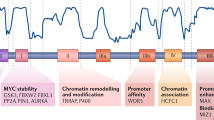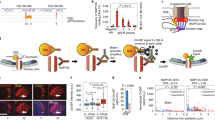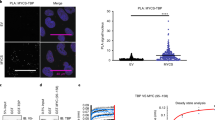Abstract
Previous work has demonstrated that E2F proteins regulate the expression of various genes encoding proteins essential for DNA replication and cell-cycle progression. E2F1 in particular is required for the initial entry to the cell cycle from a quiescent state and is required for the activation of other E2F genes. Other work has demonstrated a role for the Myc transcription factor in the activation of a large number of genes associated with cell growth, including E2F genes. We now show that Myc is required to allow the interaction of the E2F1 protein with the E2F gene promoters. As such, Myc thus provides a link between the development of a growth-competent state during the initial stage of G1 and the activation of genes essential for DNA replication at G1/S.
This is a preview of subscription content, access via your institution
Access options
Subscribe to this journal
Receive 50 print issues and online access
$259.00 per year
only $5.18 per issue
Buy this article
- Purchase on Springer Link
- Instant access to full article PDF
Prices may be subject to local taxes which are calculated during checkout






Similar content being viewed by others
References
Adams MR, Sears R, Nuckolls F, Leone G, Nevins JR . (2000). Complex transcriptional regulatory mechanisms control expression of the E2F3 locus. Mol Cell Biol 20: 3633–3639.
Bello-Fernandez C, Packham G, Cleveland JL . (1993). The ornithine decarboxylase gene is a transcriptional target of c-Myc. Proc Natl Acad Sci USA 90: 7804–7808.
Cole MD, McMahon SB . (1999). The Myc oncoprotein: a critical evaluation of transactivation and target gene regulation. Oncogene 18: 2916–2924.
DeGregori J, Kowalik T, Nevins JR . (1995). Cellular targets for activation by the E2F1 transcription factor include DNA synthesis and G1/S regulatory genes. Mol Cell Biol 15: 4215–4224.
Eisenman RN . (2001). Deconstructing Myc. Genes Dev 15: 2023–2030.
Fernandez PC, Frank SR, Wang L, Schroeder M, Liu S, Greene J et al. (2003). Genomic targets of the human c-Myc protein. Genes Dev 17: 1115–1129.
Frank SR, Schroeder M, Fernandez PC, Taubert S, Amati B . (2001). Binding of c-Myc to chromatin mediates mitogen-induced acetylation of histone H4 and gene activation. Genes Dev 15: 2069–2082.
Giangrande P, Zhu W, Rempel RE, Laakso N, Nevins JR . (2004). Combinatorial gene control involving E2F and E box family members. EMBO J 23: 1336–1347.
Giangrande PH, Hallstrom TC, Tunyaplin C, Calame K, Nevins JR . (2003). Identification of the E box factor TFE3 as a functional partner for the E2F3 transcription factor. Mol Cell Biol 23: 3707–3720.
Grandori C, Cowley SM, James LP, Eisenman RN . (2000). The Myc/Max/Mad network and the transcriptional control of cell behavior. Annu Rev Cell Dev Biol 16: 653–699.
Hallstrom TC, Nevins JR . (2003). Specificity in the activation and control of transcription factor E2F-dependent apoptosis. Proc Natl Acad Sci USA 100: 10848–10853.
He T-C, Zhou S, Da Costa LT, Yu J, Kinzler KW, Vogelstein B . (1998). A simplified system for generating recombinant adenoviruses. Biochem Biophys Res Commun 95: 2509–2514.
Johnston LA, Prober DA, Edgar BA, Eisenman RN, Gallant P . (1999). Drosophila myc regulates cellular growth during development. Cell 98: 779–790.
Kong L-J, Chang JT, Bild AH, Nevins JR . (2007). Compensation and specificity of function within the E2F family. Oncogene 26: 321–327.
Leone G, DeGregori J, Sears R, Jakoi L, Nevins JR . (1997). Myc and Ras collaborate in inducing accumulation of active cyclin E/Cdk2 and E2F. Nature 387: 422–426.
Leone G, DeGregori J, Yan Z, Jakoi L, Ishida S, Williams RS et al. (1998). E2F3 activity is regulated during the cell cycle and is required for the induction of S phase. Genes Dev 12: 2120–2130.
Leone G, Sears R, Huang E, Rempel R, Nuckolls F, Park C-H et al. (2001). Myc requires distinct E2F activities to induce S phase and apoptosis. Mol Cell 8: 105–113.
Lin W-C, Lin F-T, Nevins JR . (2001). Selective induction of E2F1 in response to DNA damage, mediated by ATM-dependent phosphorylation. Genes Dev 15: 1833–1845.
Morita S, Kojima T, Kitamura T . (2000). Plat-E: an efficient and stable system for transient packaging of retroviruses. Gene Therapy 7: 1063–1066.
Orian A, van Steensel B, Delrow J, Bussemaker HJ, Li L, Sawado T et al. (2003). Genomic binding by the Drosophila Myc, Max, Mad/Mnt transcription network. Genes Dev 17: 1101–1114.
Sears R, Ohtani K, Nevins JR . (1997). Identification of positively and negatively acting elements regulating expression of the E2F2 gene in response to cell growth signals. Mol Cell Biol 17: 5227–5235.
Takahashi Y, Rayman JB, Dynlacht BD . (2000). Analysis of promoter binding by the E2F and Rb families in vivo: distinct E2F proteins mediate activation and repression. Genes Dev 14: 804–816.
Walker W, Zhou ZQ, Ota S, Wynshaw-Boris A, Hurlin PJ . (2005). Mnt-Max to Myc-Max complex switching regulates cell cycle entry. J Cell Biol 169: 405–413.
Wei C-L, Wu Q, Vega VB, Chiu KP, Ng P, Zhang T et al. (2006). A global map of p53 transcription factor binding sites in the human genome. Cell 124: 207–219.
Author information
Authors and Affiliations
Corresponding author
Additional information
Supplementary Information accompanies the paper on the Oncogene website (http://www.nature.com/onc)
Supplementary information
Rights and permissions
About this article
Cite this article
Leung, J., Ehmann, G., Giangrande, P. et al. A role for Myc in facilitating transcription activation by E2F1. Oncogene 27, 4172–4179 (2008). https://doi.org/10.1038/onc.2008.55
Received:
Revised:
Accepted:
Published:
Issue Date:
DOI: https://doi.org/10.1038/onc.2008.55
Keywords
This article is cited by
-
Regulation of self-renewal and senescence in primitive mesenchymal stem cells by Wnt and TGFβ signaling
Stem Cell Research & Therapy (2023)
-
Contaminants from dredged sediments alter the transcriptome of Manila clam and induce shifts in microbiota composition
BMC Biology (2023)
-
Adrenomedullin-CALCRL axis controls relapse-initiating drug tolerant acute myeloid leukemia cells
Nature Communications (2021)
-
HAS3-induced extracellular vesicles from melanoma cells stimulate IHH mediated c-Myc upregulation via the hedgehog signaling pathway in target cells
Cellular and Molecular Life Sciences (2020)
-
Pre-treatment with the CDK4/6 inhibitor palbociclib improves the efficacy of paclitaxel in TNBC cells
Scientific Reports (2019)



